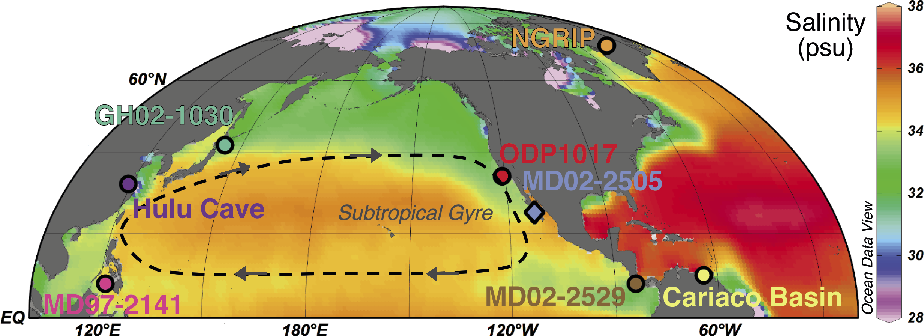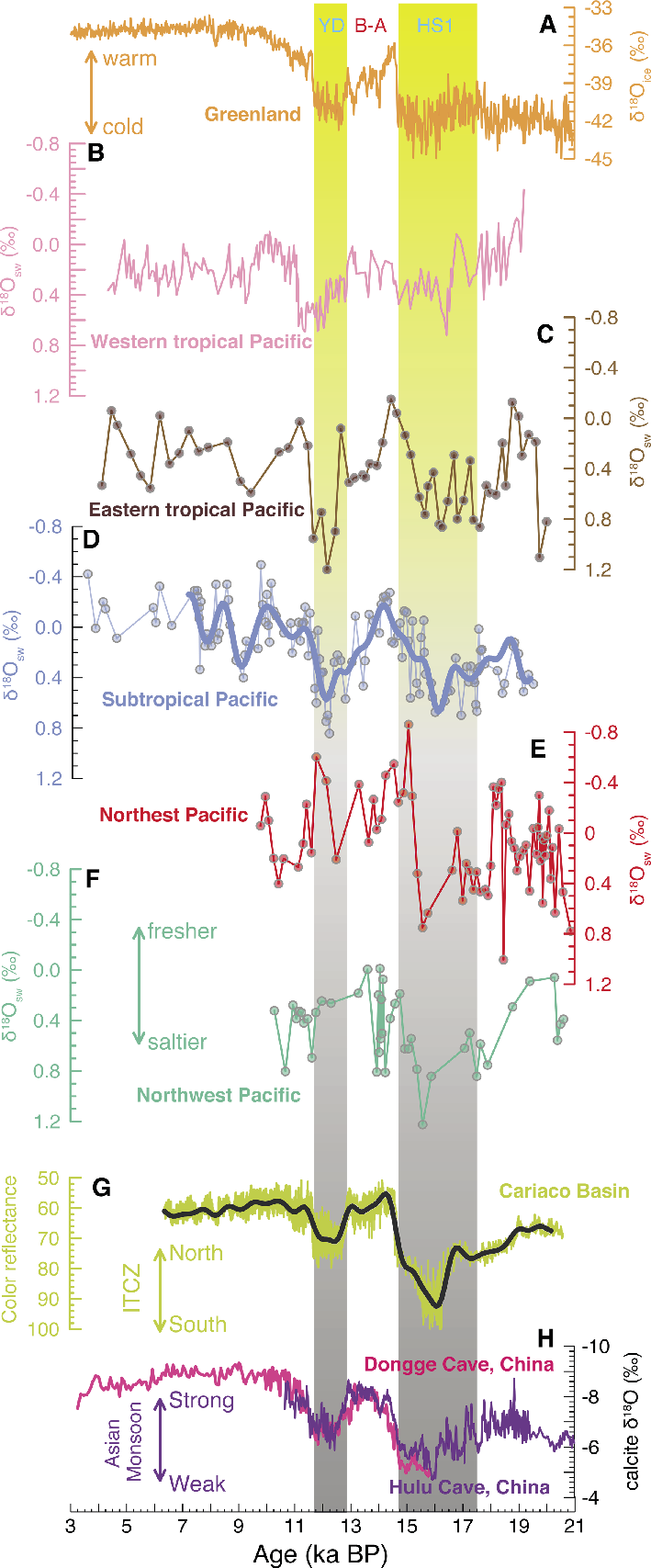- Home
- Publications
- PAGES Magazine
- Widespread Salinification of The North Pacific Ocean During The Last Glacial Termination
Widespread salinification of the North Pacific Ocean during the last glacial termination
Laura Rodríguez-Sanz and P. Graham Mortyn
Past Global Changes Magazine
23(1)
6-7
2015
Laura Rodríguez-Sanz1 and P. Graham Mortyn2,3
During the last glacial termination, atmospheric and oceanic teleconnections promoted millennial-scale episodes of widespread salinification in the tropical and extratropical Pacific Ocean that coincided with the Younger Dryas and Heinrich Stadial 1 cold phases in the North Atlantic.
 |
|
Figure 1: Modern Northern Hemisphere Sea surface salinity and location of the studied paleoclimatic records. Salinity data are from Ocean Data View (http://odv.awi.de/en/data/ocean/world_ocean_atlas_2005/). |
It has long been debated how ocean circulation may have responded to the decline in the formation of North Atlantic Deep Water and weakened Atlantic Meridional Overturning Circulation (AMOC) during Heinrich Stadial 1 (HS1) and the Younger Dryas (YD). Proxy-data and model simulations suggest that convective overturning in the North Pacific reached down to intermediate (ca. 1-2 km; Jaccard and Galbraith 2013) or even deep (3 km) levels (Okazaki et al. 2010; Rae et al. 2014) during HS1, while the water column appears to have been more stable during the YD. It has been proposed that intermediate/deep water formation in the Pacific Ocean hinges on a basin-wide increase in ocean salinity driven by changes in, e.g. the strength of the Asian Monsoon, the transport of moisture from the Atlantic to Pacific, and in the North Pacific storm tracks (Emile-Geay et al. 2003). To provide an overview of the North Pacific hydrography, of its circulation, and of the potential for overturning during the last glacial termination (T1), we gathered data from several tropical and sub-tropical sites that reveal the timing and spatial distribution of surface ocean salinity changes in this region (Fig. 1).
Salinification of the North Pacific
Seawater stable oxygen isotope data (δ18OSW) derived from paired Mg/Ca-δ18O measurements in planktic foraminifera is widely applied to reconstruct salinity fluctuations in the past. This approach uses the linear relationship between δ18OSW and seawater salinity observed at regional scales in the modern ocean (LeGrande and Schmidt 2006). During HS1 and the YD (Fig. 2A), millennial-scale δ18OSW increases at several locations in the mid- to low-latitude North Pacific (Fig. 1) indicate an overall salinification of the surface ocean (Fig. 2B-F). This picture is, however, complicated by the superimposed regional variability, likely in connection with more local circulation changes and freshwater inputs. This might explain, for instance, why salinification during HS1 was more subtle in the western tropical Pacific (Fig. 2B) than elsewhere in the basin (Fig. 2C,D).
The salinity increases in the tropical-subtropical Pacific associated with the YD and HS1 (Fig. 2B-D) coincided with cold conditions in Greenland (Fig. 2A), a more southward mean position of the Intertropical Convergence Zone (ITCZ; Fig. 2G), and a weakened boreal summer monsoon (Fig. 2H). Gibbons et al. (2014) proposed that the deglacial salinity increases in the tropical Pacific, and more widely in the Indo-Pacific region as a whole, reflect large-scale reorganizations of the hydrological cycle in response to reduced inter-hemispheric temperature gradients modulated by the AMOC slowdowns during T1. The salinity maxima coinciding with the YD and HS1 in the Western Equatorial Pacific (Rosenthal et al. 2003) have been ascribed to the millennial-scale weakening of the Asian Monsoon (Wang et al. 2001). Leduc et al. (2007) invoked that Atlantic-to-Pacific transport of moisture must have been reduced in response to the southward displacement of the ITCZ (Fig. 2G) to explain similarly timed millennial-scale salinification phases in the Eastern Equatorial Pacific (Fig. 2C). The northward expansion of these eastern tropical salinity anomalies at the expense of the fresher California Current likely controlled the salinification at 25°N off the Baja California Margin (Fig. 2D). This was possibly in response to reorganizations of the atmospheric circulation over the North American continent and/or El Niño conditions (Rodríguez-Sanz et al. 2013). Similar processes may have also controlled the surface ocean salinification at 34°N along the California Margin (Fig. 2E) during HS1, whereas the local hydrographic response during the YD apparently occurred in the opposite sense, i.e. with a freshening (Pak et al. 2012). Interestingly, at 42°N on the western side of the Pacific Ocean (Fig. 2F) salinification is also recorded for HS1, but not for the YD (Sagawa and Ikehara 2008). Likewise, a paleosalinity reconstruction obtained from organic-walled dinoflagellate cyst assemblages from the Northeast Pacific (de Vernal and Pedersen 1997) documents saline conditions in this sector of the basin during HS1 but not during the YD (not shown).
Implications for North Pacific overturning
The salinification of the tropical and sub-tropical North Pacific, and the northward advection of saline waters across the basin during the deglacial intervals of weakened AMOC has been proposed as a key process for activating and sustaining the North Pacific overturning (Okazaki et al. 2010). However, several shortcomings challenge the picture of the interactions between ocean and climate change in the North Atlantic: response of the atmospheric circulation across the North American continent and the Indo-Pacific Ocean, and the influence of Pacific salinity on the basin’s overturning. For example, the salinity anomalies in the tropical Pacific up to 25°N are of similar amplitude during both HS1 and the YD (Fig. 2B-D). This is in contrast to the evidence that changes in the mean position of the ITCZ and the Asian Monsoon (Fig. 2G-H) were more prominent during HS1 than during the YD (Wang et al. 2001; Deplazes et al. 2013). There is therefore an apparent mismatch between the magnitude of change in the drivers and the response of the salinity budget of the Pacific Ocean. This may allude to complementary factors affecting the hydrography of the tropical and subtropical North Pacific and/or to a “saturation” of the salinity signal during extreme shifts in the position of the ITCZ and monsoon strength.
Another intriguing feature of the spatial and temporal evolution of surface ocean salinity in the North Pacific across T1 is the apparent divide that developed during the YD between the low-latitude Pacific experiencing salinification (Fig. 2C-D) and the mid- to high-latitudes that instead either freshened (Fig. 2E) or remained stable (Fig. 2F). This raises the possibility that the North Pacific storm tracks strengthened (Emile-Geay et al. 2003) or that the positive feedback between intermediate to deep overturning and advection of subtropical saline waters to the subpolar North Pacific was not operating during the YD (Okazaki et al. 2010).
Outlook
Model simulations of freshwater inputs into the North Atlantic (e.g. Okazaki et al. 2010) have shed light on global atmospheric and oceanic processes that could have caused widespread salinification of the Pacific Ocean with possible consequences for deep water convection in the basin. Results point toward overall reduced freshwater inputs in the Pacific due to a weakening of the Asian Monsoon and southward displacement of the ITCZ, and enhanced exchange of saline water masses across the North Pacific gyres aided by a closed Bering Strait. Available paleoceanographic data could be explained by the coexistence of all of these processes during the YD and HS1. Additional model simulations and high quality salinity reconstructions across the tropical and extratropical Pacific Ocean will permit researchers to quantitatively constrain the spatial distribution of the salinity anomaly and further understand the actual mechanisms controlling the response of the Pacific Ocean to changes in AMOC.
affiliations
1Research School of Earth Science, The Australian National University, Canberra, Australia
2Institute of Environmental Science and Technology, Universitat Autònoma de Barcelona, Spain
3Department of Geography, Universitat Autònoma de Barcelona, Spain
contact
Didier Roche: didier.roche lsce.ipsl.fr
lsce.ipsl.fr
references
de Vernal A, Pedersen TF (1997) Paleoceanography 12: 821-830
Deplazes G et al. (2013) Nat Geosci 6: 213-217
Emile-Geay J et al. (2003) J Geophys Res Oceans 108, doi:0.1029/2001JC001058
Gibbons FT et al. (2014) Earth Planet Sci Lett 387: 240-251
Jaccard SL, Galbraith ED (2013) Geophys Res Lett 40: 199-203
Leduc G et al. (2007) Nature 445: 908-911
LeGrande AN, Schmidt GA (2006) Geophys Res Lett 33, doi:10.1029/2006GL026011
Okazaki Y et al. (2010) Science 329: 200-204
Pak DK et al. (2012) Paleoceanography 27, doi:10.1029/2011PA002238
Rae JWB et al. (2014) Paleoceanography 29: 645-667
Rodríguez-Sanz L et al. (2013) Paleoceanography 28: 529-538
Rosenthal Y et al. (2003) Geophys Res Lett 30, doi:10.1029/2002GL016612
Sagawa T, Ikehara K (2008) Geophys Res Lett 35, doi:10.1029/2008GL035133
